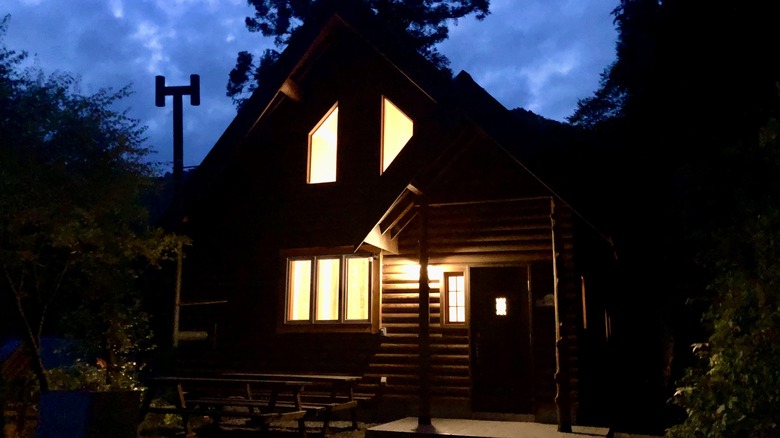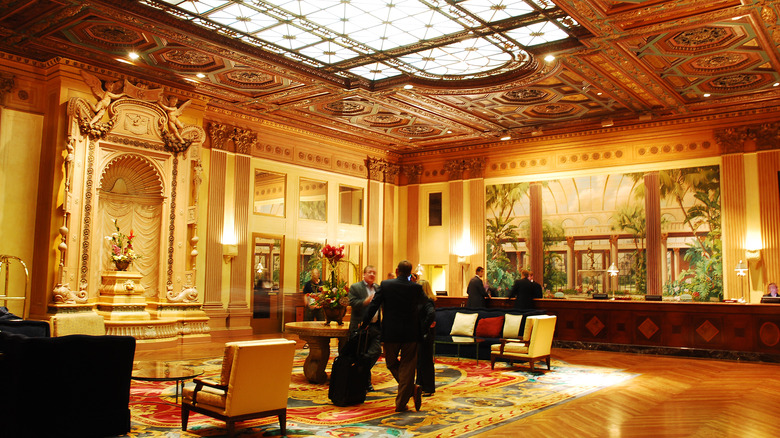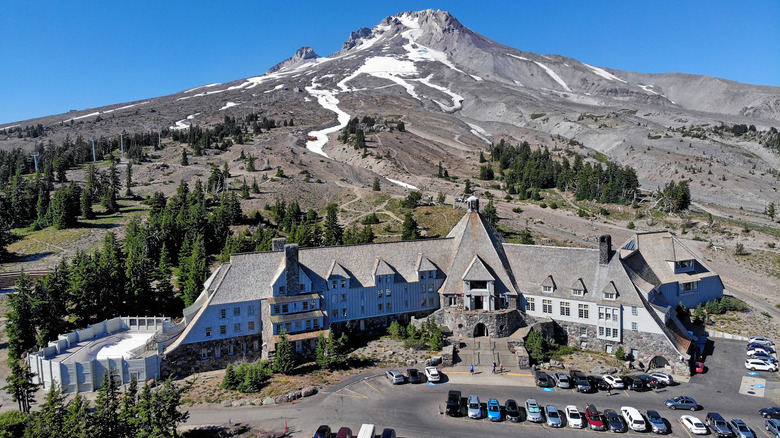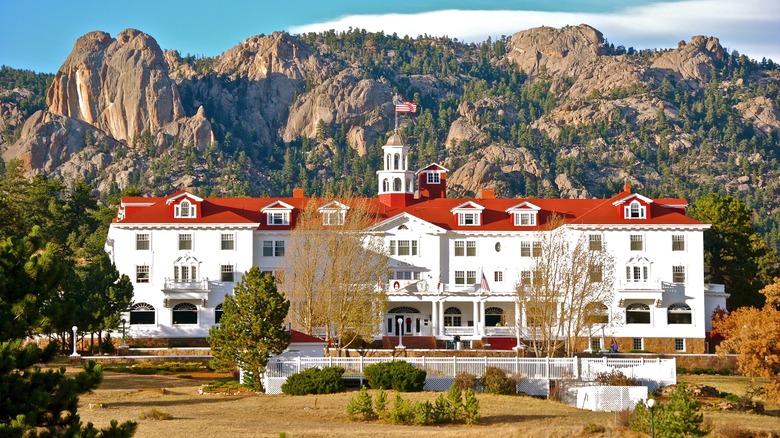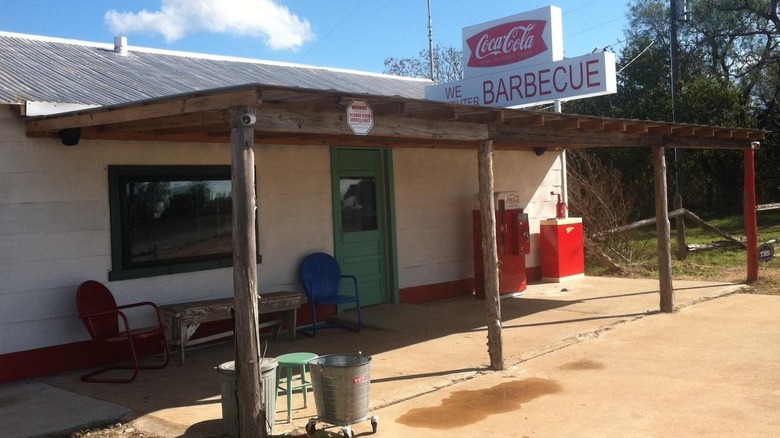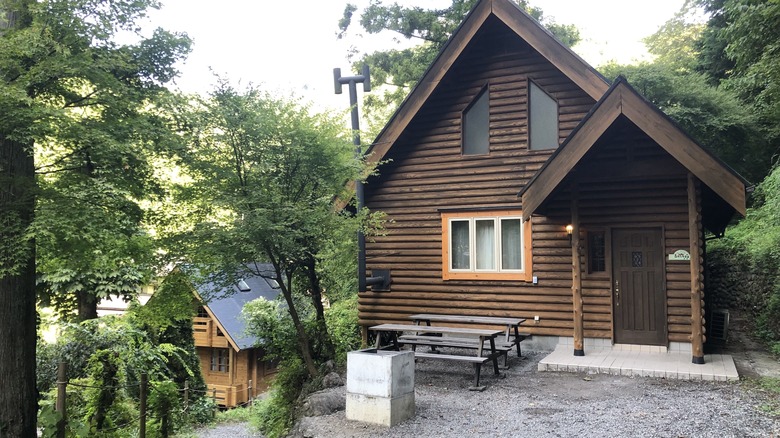Spend The Night In These Spooky Movie Hotels And Cabins (If You Dare)
Travel trouble can certainly lead to horror stories, but what about combining the thrill of a good horror movie with travel? People do it all the time, whether it be visiting Halloween Horror Nights at Universal Studios Florida or simply seeking out destinations with a claim to fame in the genre, perhaps as a filming location. One example of the latter are the famous "Exorcist" steps in the Georgetown neighborhood of Washington, D.C. In 2015, the day before Halloween, the city officially recognized those 75 steep steps as a tourist attraction with a plaque commemorating their memorable role in the film.
Unfortunately, sleeping on steps might get you in trouble for vagrancy. The good news is that there are places indoors where you can sleep that are just as well-known for their appearance in scary movies. All you need is a major credit card and maybe an exorcist travel companion to book a reservation at these places and survive the night. Most of them are open year-round, but with Halloween just around the corner, it feels like an especially appropriate time to draw up a short list of haunted hotels and creepy cabins that dance the knife's edge between terror and travel inspiration. Beware of Texas barbecue joints and hungry ghosts, not necessarily in that order. Don't say we didn't warn you.
The Biltmore Los Angeles
Now owned by Millennium Hotels and Resorts, The Biltmore Los Angeles opened in 1923, so it's celebrating its 100th anniversary this year. Over the last century, it's become deeply entrenched in Hollywood history, hosting eight early Academy Awards ceremonies from 1932 to 1942. There's now a long list of movies and TV shows where this hotel has appeared, with "Beverly Hills Cop," "Chinatown," and "Heat" being just a few classic examples set in L.A.
It's the hotel's appearance in "Ghostbusters," however, that offers the most frightful fun for prospective guests. That's right: Despite its quintessential New York setting, "Ghostbusters" used the Biltmore as the shooting location for one of its most famous sequences. We're talking about the Sedgewick Hotel scenes, where the Ghostbusters field-test their proton packs and encounter the green ghost Slimer. He's first seen pigging out on a room service cart, and they later trap him in a ballroom that's supposed to be hosting a midnight buffet.
That "ballroom" was the Biltmore's lobby. One of the Ghostbusters, Dan Aykroyd — who wrote the first draft of the screenplay based on his family's Spiritualist background — cited the Biltmore as one of the best haunted spots to grab a drink in L.A. (via The Hollywood Reporter). Though it verges on dark tourism, some folks visit the Biltmore because it is one of the last places where Elizabeth Short, the Black Dahlia, was seen alive before her notorious unsolved murder. The hotel's Gallery Bar even serves a Black Dahlia cocktail.
Timberline Lodge
Stanley Kubrick's 1980 movie adaptation of the Stephen King bestseller "The Shining" is just one chapter in the long, storied history of Timberline Lodge. The hotel, built at an elevation of 6,000 feet on the side of Oregon's Mt. Hood, was dedicated in 1937 by U.S. President Franklin D. Roosevelt. It became a National Historic Landmark in 1977 (the same year King's novel was published), so even before the movie, it was already a noteworthy place. However, it reached a new level of cinematic fame when Kubrick used it as the exterior of the fictional Overlook Hotel in "The Shining."
When the film's opening helicopter shots land on the sight of the mountainside Overlook, that's Timberline. Just don't expect to find a hedge maze with 13-foot walls there. The one in the movie was created at Elstree Studios in England. Ditto for the Colorado Lounge, where cuckoo caretaker Jack Torrance (Jack Nicholson) types reams of the same sentence, "All work and no play makes Jack a dull boy." As Looper explains, the lounge was a set construction modeled on the interior of the Alhawanee Hotel (now known as the Majestic Yosemite Hotel) in Yosemite National Park.
Timberline Lodge, which insists it's not haunted, fields more requests for King's Room 217 than any other room. (Kubrick changed the room number to the nonexistent 237 at the hotel's request.) Whereas the Overlook is closed for the winter, though, Timberline offers a 10-month ski season, North America's longest. It's a little over an hour's drive from Portland.
The Stanley Hotel
Before Stanley Kubrick directed "The Shining" or Ewan McGregor starred in the sequel, "Doctor Sleep," Stephen King's original inspiration for the Overlook came from the real-life Stanley Hotel. When viewers tuned into "Stephen King's The Shining," the 1997 TV miniseries adaptation of the book, they saw a new Overlook shot on location at the Stanley Hotel in Estes Park, Colorado. Without commercials, the three-part miniseries now plays more like a long movie, hence the hotel's inclusion here.
Like Timberline Lodge, the Stanley Hotel is listed on the National Register of Historic Places. Its location on the doorstep of Rocky Mountain National Park means it's got more to offer than just its association with King, who spent the night there in 1974 and came away with the idea for his horror novel. That's not to say the hotel is shy about its connection to "The Shining." On the contrary, it offers a Shining Ball, a Shining Tour, and a King's Cottage Tour where you can see a mint-green recreation of the bathroom in Room 237, inspired by Kubrick's adaptation of the book.
Yes, there's a Room 217 here, too: One of the hotel's "Spirited" Rooms, the Stephen King Suite features a king-size bed and even paranormal activity, according to the Stanley Hotel. Supposedly, this hotel really is haunted, which also led the reality show "Ghost Hunters" to investigate it.
The Gas Station
Who wants a little Leatherface on their vacation? At The Gas Station in Bastrop, Texas, you shouldn't have to worry about evading a chainsaw-wielding maniac or his cannibal family, but the next best thing might be staying in a cabin on the same property where they filmed the gas station scenes for "The Texas Chain Saw Massacre."
The station building is still there, and as Entertainment Weekly notes, it was restored to its movie look in 2016, with signs for Coca-Cola and We Slaughter Barbecue out front. Like the Last Chance Gas Station in the film, this one has no fuel, but inside, you'll find a gift shop with kitschy horror memorabilia. Photo ops include a meat hook and blood bucket and a replica of the green Ford van that the group of doomed young people drive into the station in the movie.
That scene continues to be homaged in modern horror films like "X" and "The Cabin in the Woods," and if you make the 33-mile drive from Austin to Bastrop, you can act it out yourself. Don't want to spend the night in a cabin at The Gas Station? Not to worry: You can always just grab a bite and eat at one of the picnic tables before hitting the road again. Yes, there is a real BBQ menu, with beef brisket and sausage instead of human flesh (or so they say).
America Camp Village
"Ringu" — the spooky Japanese film that inspired "The Ring" and a legion of other American J-horror remakes — turns 25 this year. If you don't mind using Google Translate and are up for a little adventure, then way outside Central Tokyo on the mountainous outskirts of Okutama, you can still rent out the same cabin where the cursed videotape and the ghost girl Sadako's watery grave were found.
In the movie, the real-life America Camp Village became Izu Pacific Land, while L-6, a cabin with windows like eyes, became B4. It almost resembles a log-cabin version of "The Amityville Horror" house. The director, Hideo Nakata, told Offscreen he was influenced by that film series, so he may have chosen the cabin for that reason.
The real unease sets in at night when you're watching "Ringu" alone in this big empty cabin, and you look around and realize how similar the interior still looks to the room with the staticky TV onscreen. Cabin L-6 doesn't have a VCR, but if you bring a tablet or your laptop with you, your imagination might run wild as Sadako climbs through the screen to fulfill the curse. While there's no well visible in the crawlspace under the cabin, you can find the one that inspired "Ringu" at Himeji Castle. In the meantime, the campsite continues to advertise L-6 as the movie location, and there's a small monument outside commemorating it as such in Japanese.
